There's been a lot of buzz these past few months about Rokinon's new 24mm tilt shift offering. Many enthusiasts are interested in tilt and shift capabilities, but are not interested in shelling out the $2,000+ for the Nikon or Canon equivalents. Rokinon's entry into the field has been widely anticipated and it was finally my chance to get my hands on this little lens for a review.
Being primarily an architecture and interiors photographer, I use tilt-shift lenses on a regular basis. I use the Canon 24mm and 17mm TSE lenses more or less daily - there isn't a single shoot that goes by where I don't use these lenses extensively. They are, for certain, the bread and butter lenses of my kit. I know many Nikon shooters who could say the same, as well. So when Rokinon announced that they were entering this market, there was, as you can imagine, a lot of buzz. Both from photographers looking for backup lenses, photographers looking to get into the tilt shift game without dropping over $2,000, and from photographers who had always been curious but not curious enough to spend so much on one of these lenses.

Rokinon must have known that it was going up some of the best lenses ever made - there is no question in my mind that the new iteration of Canon's 24mm tilt shift is about as perfect as a lens will ever get. Incredible color rendition, sharpness across the frame at all apertures, and the incredible benefit of being able to tilt and shift this lens across multiple axes make this lens one of the single greatest lenses for technical 35mm photography available today. While I'm a Canon shooter, I've heard much of the same about the Nikon version of this lens, and I know many photographers who use it day in and day out.
Initial Impressions
Alright, so the lens arrives in a standard cardboard box with minimal accessories. Not the worst thing - as I'm not one for clutter and I don't need all the fluff that comes with most cameras and lenses that we buy today. So far so good, nothing crazy to note here. As soon as I unpacked it though, I had immediate mixed reactions. The lens is really good looking - somewhat reminiscent of a Canon L lens - but feels a bit plasticky in the hand. It is immediately apparent that the lens is made of plastic, and for a $1000 tilt shift lens, this didn't exactly instill confidence. I would much prefer lenses with movements and manual everything to feel completely solid. For some reason the lens doesn't come with a hood. This was mildly annoying, because when shooting architecture, light can come from the least anticipated directions and cause loss of contrast in your shots. I'll never understand the practice of not including hoods with lenses. Canon does it too, and it drives me to drink. The glass is gorgeous and I had no problems screwing it onto my camera body, unlike some 3rd party lenses I've used which took a bit of force, possibly due to some sloppier tolerances, but I digress. There was no real slop or play in the connection to the camera, and despite the plastic build it fit pretty snugly.

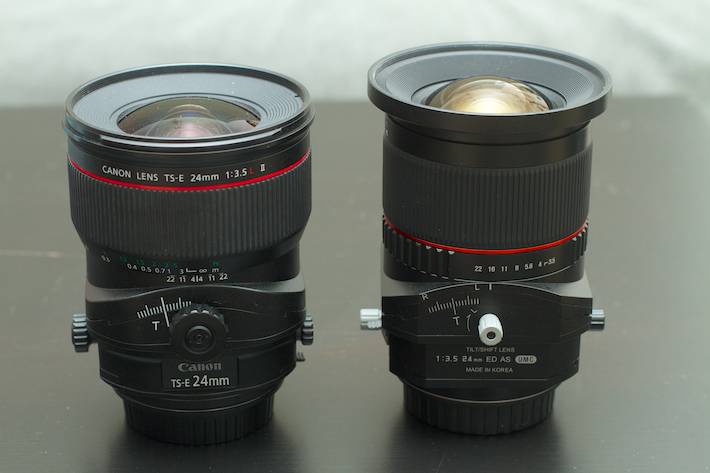
The manual aperture ring was also nice and snappy, and easy to grip and turn without looking at it. It's crisp and pretty solid feeling. However, the rest of the controls leave a bit to be desired. The knobs are again made of plastic and are pretty easy to push around and slightly bend, which, again, doesn't instill a ton of confidence. They're also really small; I have huge hands and to be honest I struggled a bit to adjust the tilt and shift accurately because of this. There were times where it was actually painful to turn the knobs because I was gripping those little things so tight while fighting gravity with almost no leverage. Check out the size of the Rokinon knobs compared to the beefy Canon knobs in the picture above and you'll see what I mean.
The manual focus ring is well-textured and wide enough to never miss. It operates smoothly and was for the most part, pretty accurate when focusing in live view. There was no slop or play here at all.
So How Does it Work in the Field?
Despite my somewhat lukewarm first reactions to this lens out of the box, I was really interested in seeing how it held up compared to my Canon tilt shifts and how it would work on my camera. I can so easily forgive the plastic and the quirks if this thing kicks butt when shooting. I'm happy to report that in my initial tests, this lens seemed to hold up fairly well when used for some casual architectural shooting. I took the lens on a stroll at a nearby office park, as well as on a walk to some cool architecture in my town, and just shot some casual snapshots on a tripod to get a better feel for how this lens works. All of these shots are with a 1d Mark III and completely raw - no editing whatsoever. Some JPEG compression is visible, as well, so keep that in mind when judging sharpness.
First, let's take a look at some general snapshots that I've taken with the lens. Everything up to this point is pretty straightforward - live view, manual focus at 10x magnification, and snap away. I wanted to use the lens in a manner consistent with the way most people will use this lens - on a tripod, stopped down between f7.1 and f11-13. I'm going to be completely honest here, in owning a number of tilt shift lenses over the years, I can count on one hand the amount of times I've used them handheld. Sure, you CAN, but do you really want to? It's such a pain in the butt that I've almost entirely foregone shooting my tilt shifts handheld unless I'm in a big pinch. So, in an effort to keep this practical and true to life, I'm using this lens how I'd use my other lenses on a job. If you're looking for a more technical review, check out the LensRentals.com review of this lens, which has plenty of charts and numbers to view. The first thing I did was setup, focus, and shift this thing as high as it went to capture a building that was relatively close, as seen here:
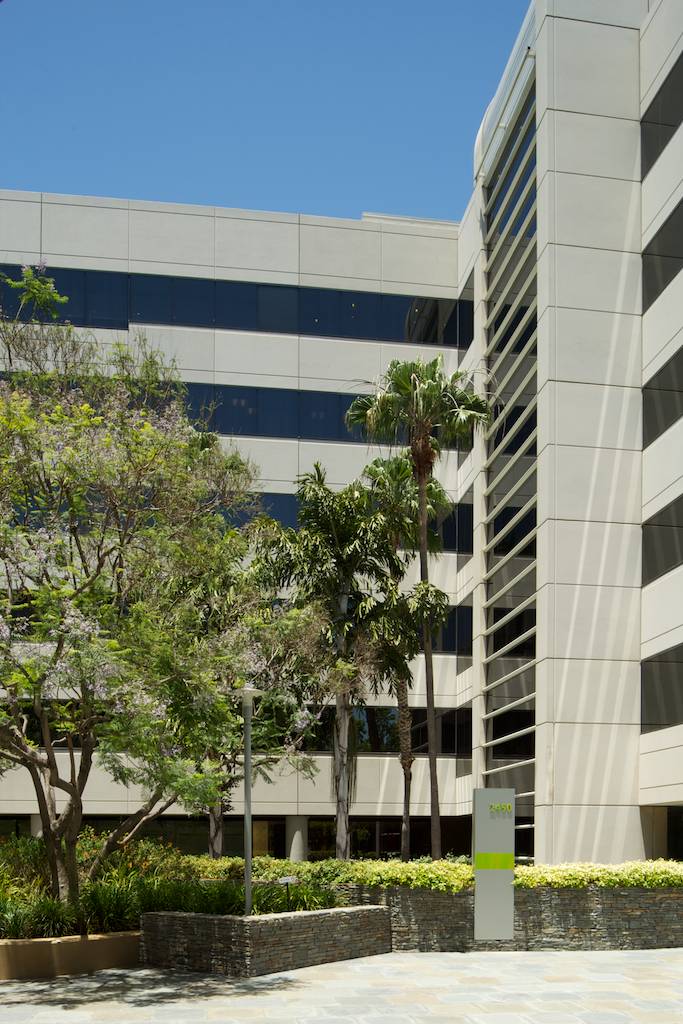
You can see the major shift up, as the building seems to be slightly distorted near the top. Here's a 100% crop of the corner, showing that this lens is decently sharp when used at the extremes. This would clean up very well with a bit of sharpening.

Here's another image, but this time only with a moderate shift up:

And at 100%:

As you can see, if we zoom into 100% on the tree in the upper right corner, this lens really is surprisingly sharp. Keep in mind that I'm stopped down to around f11 here, and for any architectural purpose, f11 on a tripod is totally feasible. Again, I've never even come close to shooting a tilt shift lens wide open on an architectural gig, and for all intents and purposes, I'd really not have much of a problem with using this lens on a paying shoot because at these smaller apertures, the sharpness difference may be negligible from this lens to the Canon and Nikon equivalents.
Stopped down, the lens also handled high-contrast areas rather nicely:
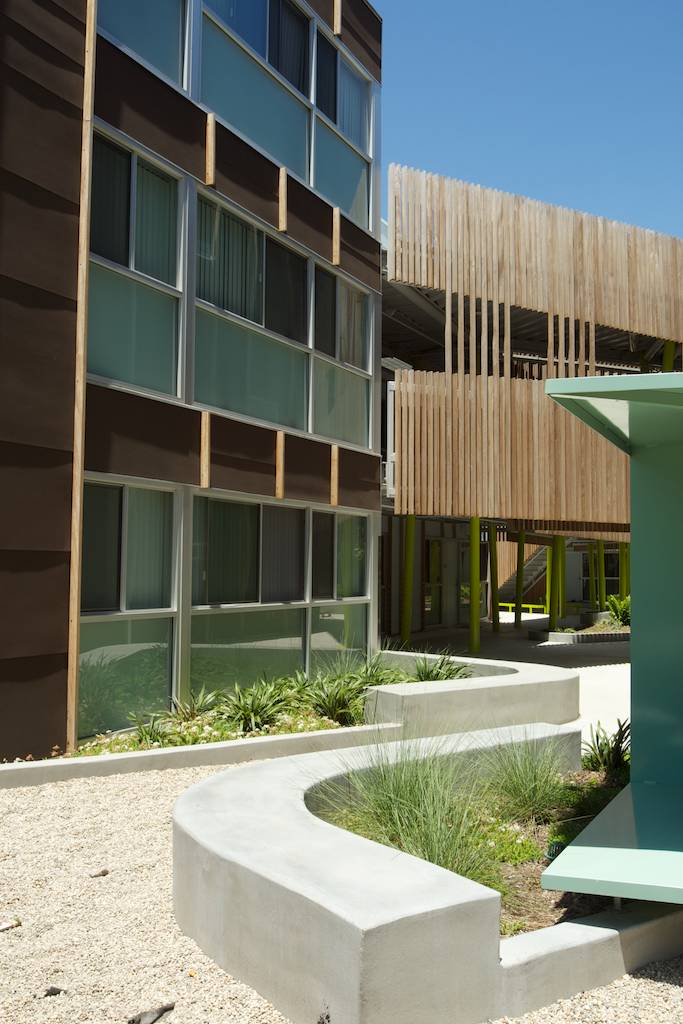
And at 100%:
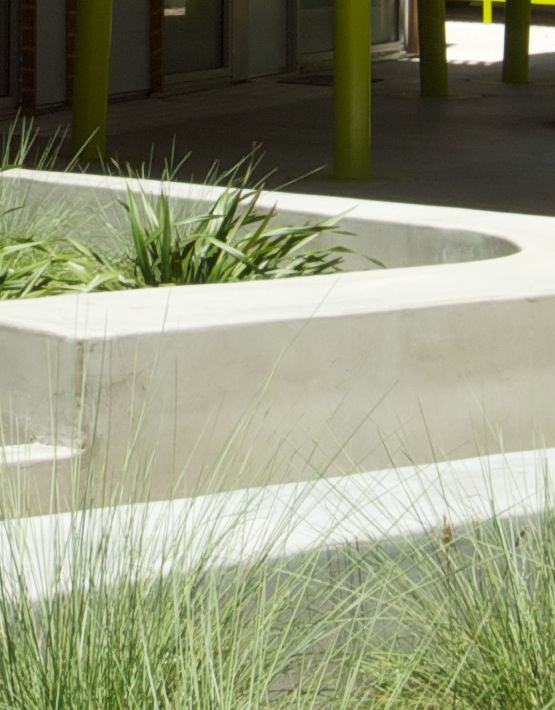
There is, however, a slight bit of barrel distortion evident with this lens, as I've highlighted below with the teal ruler lines. You can see how the vertical lines ever so slightly bow outwards:
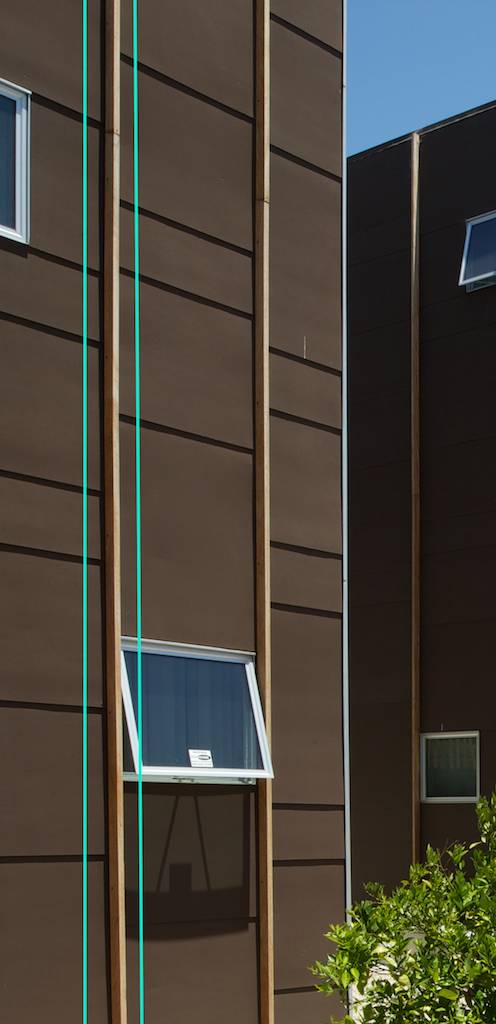
In Canon's version of this lens, the barrel distortion is entirely negligible, and the Nikon suffers from just a touch. The Rokinon's is noticeable, and I would absolutely have to correct this before delivery to a high end client. A minor annoyance, but not a total dealbreaker if I'm looking to save a grand on my first tilt shift.
Oh yeah. It totally gets artsy, too. If we apply a bit of tilt, you are greeted with nice out-of-focus areas that are able to be controlled to create that miniature effect that everyone seems to like quite a bit, though my experience with this practice is admittedly rather limited.

It was at this point, however, that I started to notice another quirk of this lens. For some reason, there is almost no resistance, tension, or friction in the shift and tilt mechanisms. What I mean by this is that when the lens is mounted on a camera and all of the knobs are unlocked, the part of the lens forward of the tilt and shift joints just drops entirely as far as it will go. I found this to be really, really annoying - as soon as you unlock the tilt or shift joints, and let gravity do its thing, the lens just sags all the way down. Then you've got to reposition the lens for your next shot using those impossibly small knobs.
My Verdict
So, as you can see, for this test, I used the lens just like I would any of my other tilt shift lenses, in an effort to keep things practical and not turn this into a measurebation-fest. That being said, would I be happy to use this lens professionally? Yes, I would - the lens is plenty sharp at the working apertures that I use it at and it gets the job done. My big hesitation here is that the build quality and 'kinks' so to say, are a bit unlovable. I don't want to knock the build quality too hard because I haven't been using it for an extended period of time, and it may hold up just fine. Look at Canon Rebels for instance - those are plastic and they are tough as tanks. But the sloppy tolerances in the knobs, lack of tension, and nearly all-plastic construction don't make me want to rely on this lens in the long term.
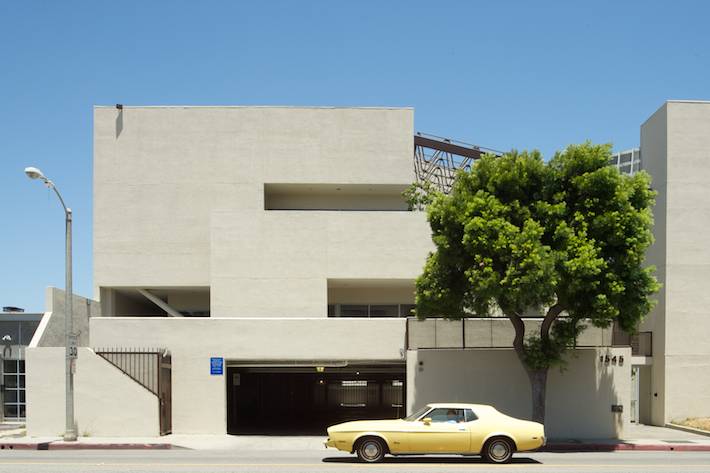
To sum this up, I'd put it this way: If you're serious about purchasing a tilt shift that will last forever, be perfect in every way, and completely justify the purchase price, keep saving for a Canon or Nikon 24mm (in Canon's case, the new version II is the one you want, the old one is garbage). I would be happy to use the Rokinon as a backup to my Canon if it ever went down, but I know that the quirks I've mentioned above would probably drive me crazy after owning Canon's perfect tilt-shifts. If you're in desperate need of a tilt-shift or you're okay with living with these shortcomings, you'll be very happy with the Rokinon. At screen resolution and in print, when stopped down, it's going to be virtually indistinguishable from the Canon or Nikon versions.


I have to say that using the Canon versions has spoiled me a bit. They are seriously as perfect as lenses will get, and while Rokinon is offering a solid product at a good price, I would have been much happier with it had they made the body out of metal and beefed up the tilt and shift mechanisms and knobs. The slight barrel distortion is totally forgivable at this price point, but spending an extra $50 to make these out of all metal would have made this a great buy. Hell, I don't really know how much more it would have been to make the body entirely metal like the Canon or Nikon versions, but I'm sure the difference would not be very scary at all. For $1100 and a full metal body, this would have been a great, great buy.
All of this being said, I'd still rather have the Rokinon tilt shift than ANY conventional zoom lens (e.g. Canon 17-40, 16-35, Nikon 12-24, 17-35) for shooting architecture. Tilt and shift movements are just that valuable when it comes to this type of shooting, and I'd happily deal with the shortcomings in exchange for being able to adjust perspective. Paired with a telephoto extender, you'd be pretty set with just one 24mm tilt shift.
What I liked:
- Relatively sharp given the price and features
- Great contrast and color
- Cheaper than the competitors
- Tilt and shift movements - invaluable for architecture
What could use improvement:
- Plastic construction
- Weird 'lens sag' leads to a flaccid lens when knobs are unlocked, exacerbated by the tiny, hard-to-use knobs
- Marginal barrel distortion
- Lack of hood (seriously, it's 2013, there is no excuse for this from any company)
You can purchase this lens, along with the Canon and Nikon equivalents, at B&H Photo Video for $999 ($989 for Canon), $2199, and $2029, respectively.
Worth Noting: The image supplied to us show the lens with much thicker adjustment knobs. See the featured image at the top of the article compared to the images that I took of the lens in my possession. Those thicker knobs would be great to have. I've reached out to Rokinon for comment and will update the article accordingly, as this was one of my major gripes with the lens.







Thanks Mike for the great review. Something here makes we wanna jump in and get a T/S lens. Cheers
Would it be possible to modify the knobs with washers or something to make it easier to turn?
I'm sure it's possible, but the fact remains you shouldn't have to.
If you are keeping this lens, try a bit of 'Sugru' for the knobs, seriously.
Good review, a little on the wordy side maybe.
I was never one for brevity =
Thanks for taking the time! It's a labor of love, one that I don't have the patience to do. I APPRECIATE people who test gear for the benefit of those of use who don't.
Perfect review, tells me what I need to know with great examples, thanks!
If I have the Canon 17mm T/S, would you recommend getting a 1.4x teleconverter or spending the additional money to get the Rokinon 24mm T/S?
From what i understand, TC's dont typically work on wide angle lenses....
http://www.lensrentals.com/blog/2009/01/teleconverters-101
Although not in the user manual, the 1.4x TC is know to work with the T/S lenses.
The question is not whether it will work, but whether the 1.4x TC would provide better results on the Canon 17mm T/S versus getting the 24mm Rokinon T/S
Compare here:
http://www.the-digital-picture.com/Reviews/ISO-12233-Sample-Crops.aspx?L...
It's actually a close call. At f/5.6 I'd give it to the 17+TC, but at f/11 it's the other way around.
I think it comes down to other factors than sharpness, such as if you have other lenses that could benefit from a TC, or if you use the tilt/shallow DOF effects and would rather have 24/3.5 instead of 24/5.6, or if you intend to mount filters.
Thanks for the review, Mike! It's a bit of a shame. I rented the Canon TS-E 24mm from LensRentals, and fell in love with it. It's a rugged and unbelievable lens. I was fine with the Rokinon right up until the point when you said the knobs bent. I will *not* worry about breaking some cheap part of a lens in the middle of a shoot. I'm careful with my gear, but I do use it. I'll save for the Canon, thank you very much.
This may be considered nit-picking, but why are you calling this a Rokinon lens? I know you may have gotten it through the Rokinon distributor, but this is a Samyang lens, engineered and built by Samyang in Korea. Rokinon is a distributor of disparate products from different manufacturers, owned by Elite Brands of New York.
Probably b/c most people don't care who the distributor is....it says Rokinon on the lens....that's what people will search for.....you can buy both from B&H....throwing the Samyang part in there might confuse people....
http://tinyurl.com/kmakvav
LIKE I SAID, you can buy both from B&H.......they're both the exact same lens, so who cares.....
I would imagine those people might get confused...
Even with the JPG compression, the 100% crops dont look THAT sharp...ESPECIALLY for f/11....granted it's pixel peeping, and the un-cropped shots look great....but i dont consider those crops "Pretty damn sharp!"
On a side note, great review otherwise, i like that you mentioned big things like the construction, and the tilt/shift directions not having much resistance....that makes me wanna bypass this lens for now....good to know!
No doubt the Canon and Nikon lenses are sharper, but you also need to note that those are also unsharpened images. Most people are used to seeing images sharpened. You would have to see how the Nikon or Canon optics will look under the same conditions. You may want to consider renting it from LensRentals and see if it pans out for your needs under your shooting and post-processing conditions.
I've read that Canon dominates the architectural photo market, with most serious pros who say the 17 and 24mm TS Canons are far superior the the Nikons (and they don't do a 17mm TS). I know the 14-24 is also envied - by Canon shooters. Nikon certainly seems to need something comparable to Canon's 17 TS. As a Nikon guy (who aspires to do more architecture and interiors), I'd be curious on your thoughts. I'd love the 14-24mm!
LOL, re: "an effort to keep things practical and not turn this into a measurebation-fest"
The 14-24 is envied by canon shooters to such a degree that some people just buy a converter ring and use it as a MF-only lens. Mostly because this is the only FF ultrawide zoom that is actually usable at f/2.8.
The 14-24 is obviously not a shift-lens, so it's probably more of a "landscape" than an "architecture" lens. Though T/S lenses are very much specialty lenses, and the 14-24 is "just" ridiculously good.
Agreed - 14-24 is super, super cool and I'd love one. I would rarely use it for architecture, though. Too wide and no need for the 2.8.
The ultrawide angles still works for architecture when you want to use some perspective tricks. The inside of a cathedral is often "helped" into looking much larger and impressive than it really is, and you might actually need that f/2.8 if tripods aren't allowed. But now we're perhaps more in the intersection of "travel" and "architecture".
I shoot most my architecture and landscapes as panoramas, for all that sweet sweet resolution. Or for the Brenizer effect. Or for focus stacking close objects.
I'd probably be better served with the 14-24 before getting a TS lens. A 5DMkIII with 17mm TS would be nice too ;)
Non-PC architectural images on a Nikon are better done with older Ai optics like the 28mm f/2.8 and the harder to get 15mm f/5.6 lens. These are true rectilinear lenses, straight lines remain straight, not like the crap that is passed off today as a "rectilinear" wide-angle, which are a joke at best. The 13mm Nikkor was also this way, but they're completely impossible to obtain today. To a lesser extent, the 18mm f/3.5, 20mm f/4, and the 24mm f/2.8 were decently rectilinear lenses.
@Spy: I worked at the LA Times as a staff photog for 20 years in the golden years 1980-2000. We had amazing pool gear including that 15mm, which some also had as personal gear. It was amazing! Of course, there was no "cheating" then, i.e. correcting the lens distortion in software. It had to be right in camera.
Yep. People don't realized that software correction comes at a price of loss of detail as well.
Great review Michael. I like how you've done this from practical point of view versus as you say a "measurebation-fest" : ) I've never used a T/S lens and can certainly appreciate the superior optical qualities they have vs. a zoom lens, but can't help but wonder, for architectural photography use, if the fixed focal length of these lenses makes them less versatile than a good wide zoom in terms of our ability to compose a shot. When shooting interiors (and exteriors for that matter) we don't have unlimited options of where we can locate the camera so a zoom lens gives us the ability to frame up a shot that can be aesthetically superior to what a fixed focal length might afford. Plus we can tilt the camera and fix the verticals in post! Yes, we're stretching pixels and thus losing ultimate resolution, but a 20+ megapixel image already has a lot of resolution and the reality is our photos will almost always be downsized by an order of magnitude for final consumption - a 1080p TV is just 2 megapixels, An iPad retina display is 3.1 megapixels, even a full-page magazine photo is typically just 7.2 megapixels.
Or am I missing something? In a typical architectural shoot are you mostly using the tilt function on these lenses? All else being equal - camera location and height - can't the equivalent of a T/S lens be replicated by simply using the lens correction function in Photoshop?
Dave, thanks for the response and kind words, and thanks for taking the time to read the article and make me answer some good questions!
When you 'point the camera down' and fix it in post, you are setting yourself up to lose a substantial amount of information from the edges of the frame. In order to accomodate the 'stretching' of the image, so to say, you've got to drag the edges beyond the frame in order to straighten the verticals. So a 17mm lens pointed down and corrected in post in essence becomes a 24mm tilt shift with a bunch of quality loss from the stretched pixels. Whereas a 17mm tilt shift stays a 17mm tilt shift and has great sharp qualities throughout.
So you not only lose image quality, but physical parts of the image are going to be cut out when you stretch it beyond the edge of the frame. So you can get away with it, but you'll quickly run into the limitations and it will become pretty annoying. I hope that makes sense. It's basically a 'yes, it's possible, but a tilt shift will just do it much better the first time' type of thing.
Hi Mike, It would've been nice to see the results on a full frame body with more resolution. Just curious, do you use this camera for high end architectural clients?
I sure do. Message, not the medium. I have never really been one for gear.
I find your reply somewhat odd, since you have an article here about gear! And a 1D3 isn't exactly a poor mans body.
It can be had for under $1100 new these days, under $1000 if you're patient. And of course! I'm the resident architecture/buildings guy, which is pretty much one of the biggest reasons to buy a TS, so when it came across our desk, I was asked to review it since I had the most experience.
Hi Mike; VERY happy I read this before popping for the lens... Question; The old tse is "garbage", did you ever try the 35mm film FD TS?....Any thoughts about it with a converter? TY
Thanks Mike for this review. I know a bit later than most comments but happy it's still up. As a Sony shooter, this is really my ONLY solutions to TS and was hesitating as the other reviews are not quite a good. But, I guess I can order one and and see how it works on the a99. I'm sure your assessment is a most valid one as you are first a photographer and then a lens reviewer, not the other way around!
Thanks, Mike, for a usable, real-world review.
As I couldn't justify the cost of the Nikon version yet, I did purchase the Rokinon from an eBay store in NJ for way less than half the cost of the Nikon. I've noticed very little barrel distortion, but a good bit of chromatic aberration; however, both are nothing Lightroom or Adobe Camera Raw can't handle. I'm very pleased with the performance-to-price ratio. You were absolutely correct about it being an excellent alternative to the expensive named brands. I shoot architecture, as per your fStoppers tutorial, and also with a view camera. It is really nice to have the tilt-shift capability with the DSLR too. BTW, I like the fact that the Rokinon rotates both the tilt and the shift independently, like the Canon lens - something the Nikon PC-E won't do.
For the time being, anyway, the Rokinon is going to work out fine. Thanks again.
Did you ever get a response from Samyang/Rokinon on the knob size? My guess is they ran out of the big knobs and used the small ones to maintain production. Or they wanted to reduce their SKUs.
I know I'm a year old in commenting, but I am considering to purchase my first TS lens for Canon. I have been looking at 24mm f/3.5 L verion 1 on ebay, etc. How is the Rokinon compared to the original version of Canon 24mm TS?
I have been using this lens for some months now to photograph antique furniture for a large website. It is sharp, & produces great results used with studio flash. If anything the lens delivers a warm image. However, for a high end job the barrel distortion is just too much. The small knobs are a pain, & when using shift in portrait to correct parralax.. The whole thing has a tendancy to slip a bit.
Mike, thanks for the fantastic review. I purchased the lens and was curious about what appears to be severe fall-off when the lens is shifted all the way in either direction (see attached image). Is this something that you've experienced or do I have a lemon? Thanks again. Kai
Thanks Mike. You sealed the deal. I wanted to give the Rokinon lens one last look before making my decision. I'm ordering my Nikon 24mm today. Many thanks for that honest and fair assessment.